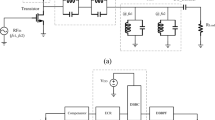Abstract
This paper uses hand analysis and a new fully numerical distortion contribution analysis technique to explain and optimize the nonlinear performance of analog circuits. Several example circuits are studied, where mixing of nonlinear distortion from one harmonic band to another is important. In some circuits the band-to-band mixing can be employed to reduce the overall distortion.













Similar content being viewed by others
References
Maas, S. (1988). Nonlinear microwave circuits. Norwood, MA: Artech House.
Wambacq, P., & Sansen, W. M. C. (1998). Distortion analysis of analog integrated circuits. Norwell, MA: Kluwer Academic Publisher.
Vuolevi, J., & Rahkonen, T. (2003). Distortion in power amplifiers. Norwood, MA: Artech House.
Pedro, J. C., & Carvalho, N. B. (2003). Intermodulation distortion in microwave and wireless circuits. Norwood, MA: Artech House.
Aikio, J. P., & Rahkonen, T. (2005). Detailed distortion analysis technique based on large-signal voltage and current spectra. IEEE Transactions on Microwave Theory and Techniques, 53(10), 3057–3066.
Aikio, J. P., Rahkonen, T., Hamina, J., Virtanen, J. (2012). Improved methods for polynomial fitting and distortion contribution analysis. Proceedings of the 7th European Microwave Integrated Circuits conference (EuMIC 2012).
Ioannis, S., Mavridis, D., Papamichail, M., & Papadopoulos, G. (2007). Large and small signal distortion analysis using modified volterra series. Journal of Analog Integrated Circuits and Signal Processing, 54(2), 133–142.
Rahkonen, T., & Aikio, J. P. (2012). Comparison of ordinary and time-varying volterra analysis for finding distortion contributions. International Journal on Analog Integrated Circuit and Signal Processing, 74, 3–9.
APLAC circuit simulator, AWR-APLAC Corp., Espoo, Finland. [Online]. Available: http://www.awrcorp.com. Accessed 07 May 2014.
Gilbert, B. (1998). The multi-tanh principle: A tutorial overview. IEEE Journal of Solid-State Circuits, 33(1), 2–17.
van der Heijden, M. P., de Graaff, H. C., & de Vreede, L. C. N. (2002). A novel frequency-independent third-order intermodulation distortion cancellation technique for BJT amplifiers. IEEE Journal of Solid-State Circuits, 37, 1176–1183.
Author information
Authors and Affiliations
Corresponding author
Rights and permissions
About this article
Cite this article
Aikio, J.P., Rahkonen, T. & Korkala, T. Analysis of band-to-band mixing distortion contributions in some usual circuit topologies. Analog Integr Circ Sig Process 80, 417–426 (2014). https://doi.org/10.1007/s10470-014-0320-2
Received:
Revised:
Accepted:
Published:
Issue Date:
DOI: https://doi.org/10.1007/s10470-014-0320-2




